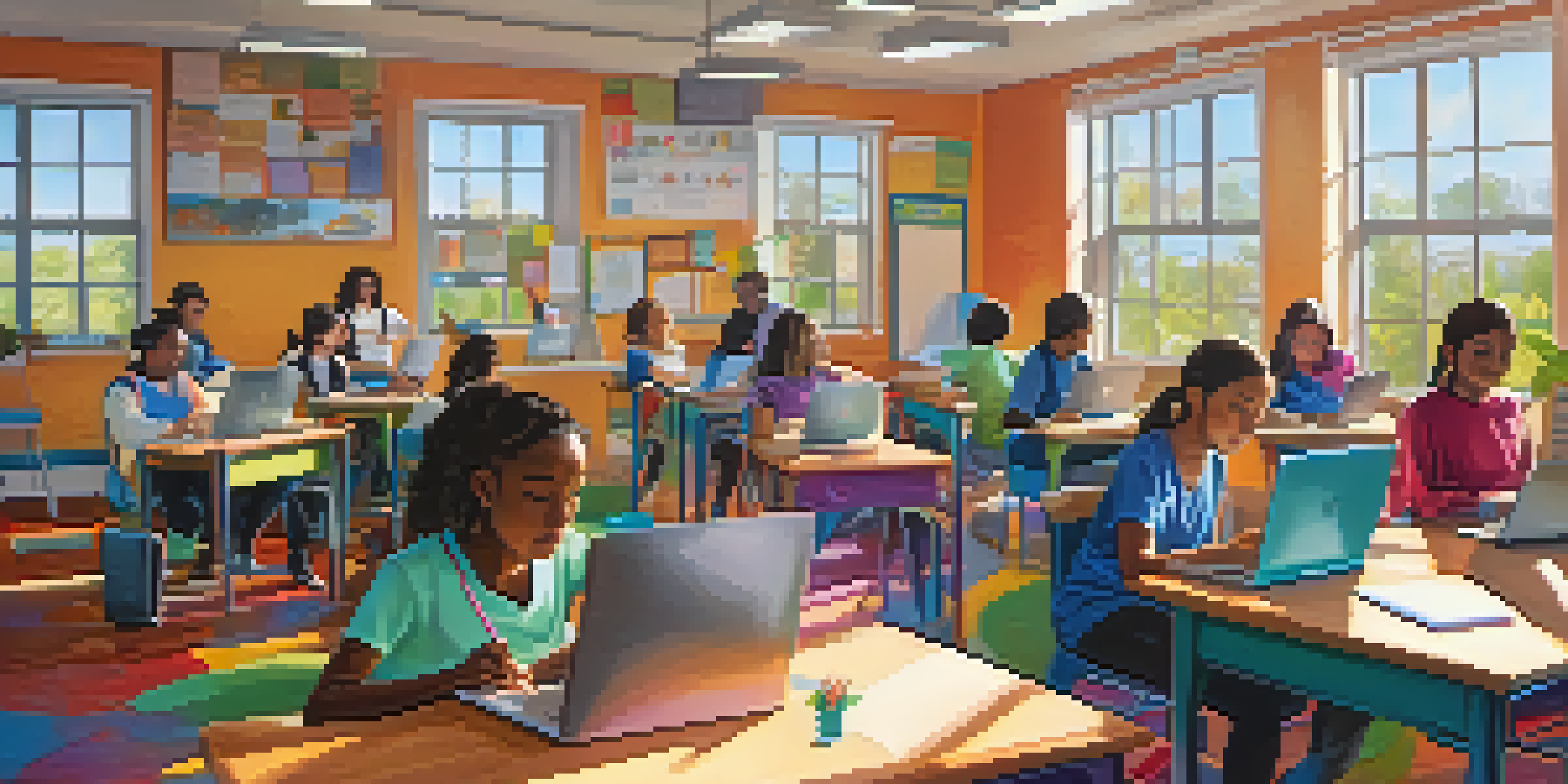Blended Learning in California: Merging Online and Offline

Understanding Blended Learning: A Quick Overview
Blended learning combines traditional classroom methods with online digital media. This approach allows students to engage with material both in-person and virtually, providing a flexible learning environment. For instance, a student might attend lectures in class while also accessing supplemental online resources for deeper understanding. By merging these two modalities, educators can cater to different learning styles and needs, making education more accessible.
Blended learning is not just a strategy; it's a revolution in education, merging technology with traditional teaching methods to create a more inclusive environment.
In California, this educational model has gained traction, especially in response to the increasing demand for personalized learning experiences. Schools are leveraging technology to create hybrid classrooms, where students can learn at their own pace while still receiving face-to-face instruction. This blend not only enhances engagement but also prepares students for a digital world that increasingly relies on technology.
Moreover, blended learning can be particularly beneficial in diverse classrooms, accommodating students from various backgrounds and learning abilities. Educators can tailor their teaching strategies, ensuring that every student receives the support they need to thrive. Ultimately, blended learning aims to create a more inclusive and effective educational landscape.
The Rise of Blended Learning in California Schools
In recent years, California schools have adopted blended learning models to address the diverse needs of their student populations. This shift has been accelerated by advances in technology and the growing acceptance of online education. Schools have started experimenting with various blended models, such as the flipped classroom, where students review content online before engaging in interactive discussions in the classroom.

With the COVID-19 pandemic, many schools were forced to transition to online learning, which prompted a reevaluation of educational delivery methods. As a result, educators discovered the benefits of blending online and offline learning, leading to a more resilient educational framework. This approach not only maintained the continuity of learning during uncertain times but also opened the door for innovative teaching practices.
Blended Learning Enhances Engagement
By combining traditional and online methods, blended learning caters to diverse learning styles and needs, making education more accessible.
As a testament to its effectiveness, blended learning has shown promising results in student engagement and achievement across California. Schools that have implemented this model report improved student performance, as learners benefit from the flexibility and resources available to them. The rise of blended learning is reshaping the educational landscape, making it a vital part of California's future.
Key Components of Effective Blended Learning
To successfully implement blended learning, certain key components must be in place. First, technology access is crucial; students need reliable devices and internet connectivity to fully participate in online components. Schools are increasingly investing in infrastructure to ensure that all students can engage with digital content seamlessly, whether at home or in the classroom.
The future of education is not just in teaching, but in how we can blend the best of both worlds to create a personalized learning experience.
Another important component is the curriculum design. Blended learning requires a thoughtful approach to lesson planning that integrates online resources with in-person activities. Educators must create cohesive experiences that provide students with opportunities to apply what they learn in both environments, fostering deeper understanding and retention.
Lastly, ongoing professional development for teachers is essential to ensure they are equipped to navigate this blended landscape. Training programs can help educators learn how to effectively utilize technology and create engaging online experiences. By prioritizing these key components, California schools can maximize the benefits of blended learning for all students.
Challenges of Blended Learning in California
While blended learning offers numerous benefits, it also presents challenges that educators must navigate. One significant hurdle is the digital divide, where some students lack access to the necessary technology or reliable internet. This disparity can hinder equitable learning opportunities, particularly in underserved communities. Addressing this issue is critical to ensuring that all students can fully participate in blended learning.
Additionally, teachers may face difficulties in transitioning to a blended model, particularly if they are accustomed to traditional teaching methods. The shift requires a mindset change, as educators must learn to facilitate online learning while maintaining engagement in the classroom. Providing adequate support and resources for teachers is essential for a smooth transition.
California's Shift to Blended Learning
The adoption of blended learning in California schools has accelerated due to technology advances and the need for personalized educational experiences.
Lastly, maintaining student motivation in a blended environment can be challenging. With the distractions of online learning, some students may struggle to stay focused and engaged. Schools must implement strategies to keep students motivated, such as setting clear expectations and fostering a supportive online community.
Success Stories: Blended Learning in Action
Across California, several schools have successfully implemented blended learning models, showcasing the positive impact on student outcomes. For example, a high school in Los Angeles adopted a flipped classroom approach, allowing students to watch lectures at home and engage in hands-on activities during class. This method has led to increased participation and improved grades among students.
Another success story comes from a middle school in San Francisco, where teachers have integrated project-based learning with online resources. Students collaborate on projects while utilizing digital tools for research and presentation. This approach not only enhances critical thinking skills but also fosters teamwork and creativity, essential skills for the 21st century.
These success stories highlight the potential of blended learning to transform the educational experience. By embracing innovative teaching practices, California schools are setting an example for others to follow, demonstrating that a blended approach can lead to improved student engagement and achievement.
The Future of Blended Learning in California
As blended learning continues to evolve, its future in California looks promising. With technology advancing at a rapid pace, educators are finding new ways to enhance the blended learning experience. Virtual reality, artificial intelligence, and adaptive learning technologies are just a few examples of innovations that could further personalize education for students.
Moreover, as more schools recognize the benefits of blended learning, we can expect to see a broader adoption of this model. Policymakers and educational leaders are increasingly advocating for blended learning as a viable solution to address the diverse needs of students. This shift will likely lead to more funding and resources dedicated to supporting blended learning initiatives.
Challenges of Implementing Blended Learning
Despite its benefits, blended learning faces challenges such as the digital divide, teacher adaptation, and maintaining student motivation.
In conclusion, the future of blended learning in California is bright, with the potential to revolutionize education for generations to come. By embracing innovation and focusing on equity, California can lead the way in creating a more inclusive and effective educational system that prepares students for success in an ever-changing world.
Conclusion: Embracing the Blended Learning Journey
Blended learning represents a transformative shift in education, merging the best of both online and offline worlds. As California schools continue to explore and refine this approach, they are paving the way for a more personalized and engaging learning experience for students. The journey of blended learning is not without its challenges, but the potential benefits far outweigh the obstacles.
By prioritizing access to technology, effective curriculum design, and teacher training, educators can create an environment where all students can thrive. Success stories from California schools illustrate the real-world impact of blended learning, showcasing how this model can enhance student engagement and achievement.

Ultimately, embracing blended learning is about fostering a love for learning and preparing students for a future where adaptability and innovation are key. As California moves forward on this journey, it serves as an inspiring example for schools across the nation and beyond.